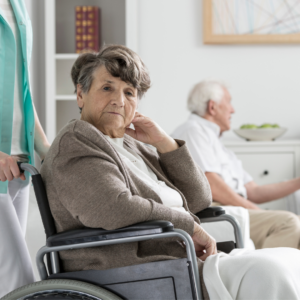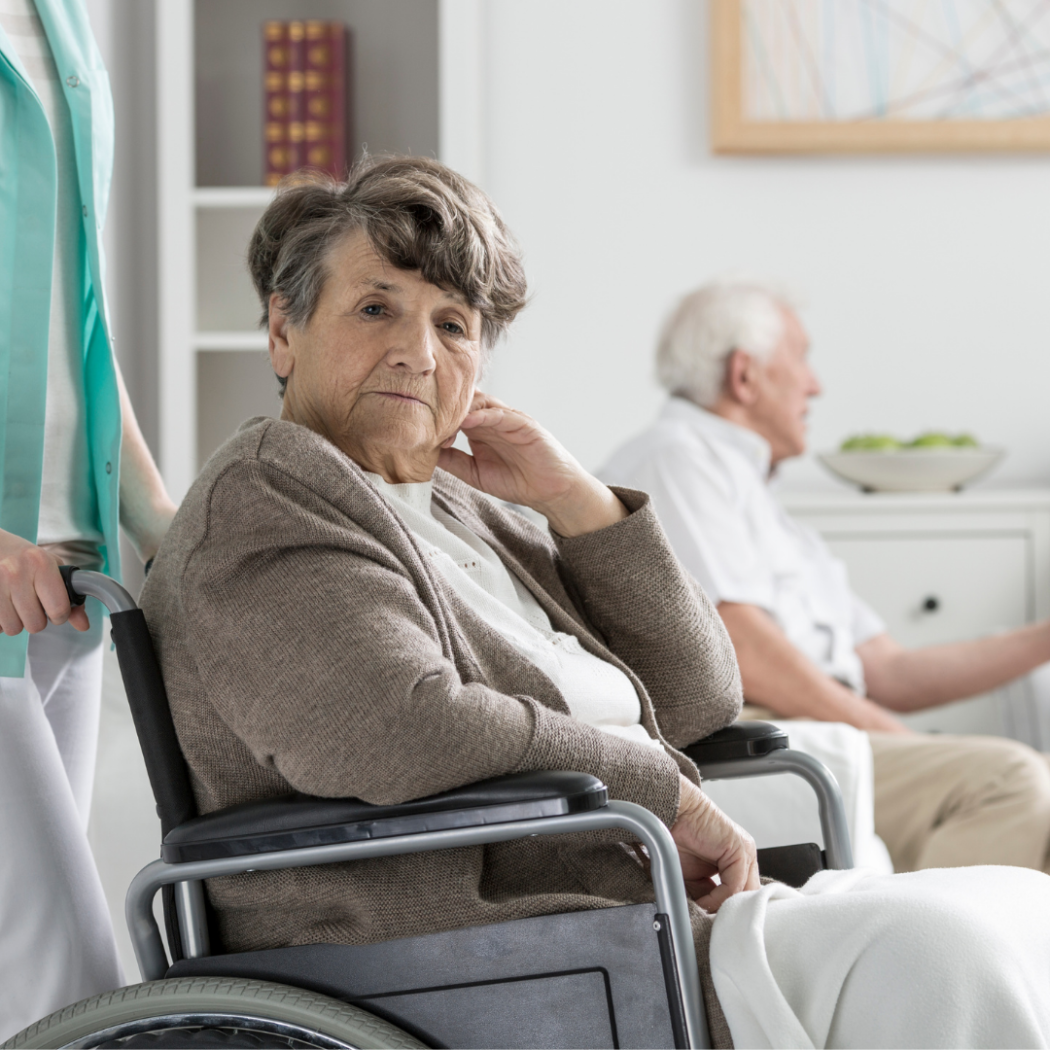On March 11, President Joe Biden signed the $1.9 trillion American Rescue Plan into law. This relief package contains measures for all Americans and targets working women and children. However, it does not adequately address the welfare of a significant segment of the population – aging adults, especially aging women.
Am I invisible? Ageism.
 Older Americans have not been entirely left out the Rescue Plan. They are included in sections that describe the mental health crisis of isolation and that identify assistance for “Grandfamilies or Kinship families.” They will also generally benefit with an improving economy. These provisions are inadequate.
Older Americans have not been entirely left out the Rescue Plan. They are included in sections that describe the mental health crisis of isolation and that identify assistance for “Grandfamilies or Kinship families.” They will also generally benefit with an improving economy. These provisions are inadequate.
As early as April 2020 the United Nations quantified the impact of the emerging crisis on aging women. Their research indicated that 57% of those 70 and older as well as 62% of those 80 and older are women. This population is growing as Baby Boomers age into it. Because women remain the designated unpaid caregivers in the United States, what happens to older women affects the lives of their female relatives.
The pandemic experiences of younger working mothers were dramatically captured in the media, uplifting their plight. However, the experiences of older Americans, especially older women, have been marginalized in print and social media.
Recall the stories and pictures of relatives desperately trying to contact assisted living and nursing home residents through closed windows. Then there were the joyful and heartbreaking videos of grandmothers hugging their grandchildren through inventively fashioned vinyl barriers, complete with shoulder length “gloves” for grandma and smaller “gloves” for grandchildren. More recently, the news has been focused on the way New York’s governor lied about the death toll in that state’s nursing homes.
Though these stories seem to center on the plight of the aging adult, they actually emphasize the pain of the relative outside the window, the ingenuity of grandma’s daughter, and the heartlessness of politicians. By making the nursing home visitor, the clever daughter, or the politician the hero or villain of the story, these vignettes downplay the situation of the person most affected – the aging adult.
Some of the most outrageous pandemic stories associated with older Americans have been forgotten. Do you recall the openly hostile comments heard from individuals, even politicians? We were told that older Americans would be glad to “sacrifice” themselves and that the pandemic was a way to cull older, less “productive” people.
Even if you brush off such comments as ridiculous or unrepresentative of the majority, you must recognize that state legislatures acted irresponsibly in dealing with vulnerable citizens. In North Carolina, as in other states, nursing homes, hospitals and other health care providers, were given broad immunity from lawsuits. The law, signed by Governor Cooper in May, was declared retroactive to March 10, 2020, the date a state of emergency was declared. The law covers far more than deaths from COVID19. It includes language that makes it nearly impossible for grieving families to hold a nursing home accountable in all wrongful death suits.
In a March 23, 2021 letter in the News and Observer, North Carolina Attorney Nick Mendez, who represents families with nursing home negligence cases, stated, “ … this act shields nursing homes from civil liability …. (and allows) them to blame every mishap on Covid” avoiding accountability. Statues of this type across the country ignore the rights of seniors. They also demonstrate the insidious nature of ageism.
Change
Repealing legislation in North Carolina and other states that gives blanket immunity to health care providers like nursing homes is necessary. Instead of shielding nursing homes, legislators should be working to shield nursing home residents from negligent, even cruel, treatment. Statues increasing oversight of these facilities and ensuring transparency in reporting practices are needed.
Specific state legislation and the American Rescue Plan will bring important change, but lasting change requires long-term solutions to adequately address the experiences of older adults, especially older women, during the 2020 pandemic.
Digging at the roots
Male or female in the US and as far away as Australia, aging is a process of devaluation. This marginalization of older adults has been labeled “an invisible human rights crisis.”
Ageism is neither recent nor solely American. However, in the emerging aftermath of Covid, the degree of worldwide attention being given to the impact of the pandemic on women has increased, suggesting new possibilities.
Avenues to fighting ageism rely on individual action first. Those witnessing or experiencing this prejudice are urged to speak-up, bringing immediate awareness to offending behaviors. Seemingly innocuous examples are easy to recognize but mask a broader general attitude. Think of the doctor who speaks over the older patient to their adult child, the salesperson who greets the older customer as “young lady.” The success of the #MeToo movement demonstrates the effectiveness of speaking-out when paired with social media.
All forms of media spread and support the devaluation of older women. They are absent from ads for products that convey energy or beauty. This is another opportunity for speaking-out. Recently, other images counter those negative stories. Images of female leaders from around the world steering their countries through the past year have emerged. At home, Vice-President Harris is exploding notions of leadership. Speaker Pelosi’s and President Biden’s energy and leadership are challenging perceptions of age.
Though the influence of speaking-up and of public images has a real effect on perception and attitude, more is required to bring the kind of change that will matter to older women and their younger sisters before the next pandemic hits. To do that, women and those organizations and individuals that support them must draw deeper from the playbook of grassroots activism. In the next election cycle, voters who have the most to gain from these changes because they lost the most in 2020 – Black, Hispanic, and low-income women of all ages – need the “Stacey Abrams approach.”
Empowered women voters will want candidates committed to making temporary parts of the American Rescue Plan permanent: a guaranteed minimum income, paid leave, and universal health care, among others. None of these actions is new, but they are proven effective. Improving all women’s lives now will have a long-term effect.
Real and lasting change
Returning to a pre-pandemic normal is neither possible nor desirable. That is the world that ignored the needs of women. That is the world that thought of recovery as creating jobs and benefits that were largely aimed at men. This time around, a 21st century solution must emerge.
In Ten Lessons for a Post-Pandemic World, Fareed Zakaria advocates a Digital Infrastructure that would support the growing digital economy and “bridge the gender digital divide.” Zakaria notes that presently men dominate the digital world, leaving out girls, women, older adults, and low and middle-income families. He points out that even in families with reliable Internet and a computer, disparities in access exist with more screen time being allotted to boys.
Eliminating the digital divide will drastically alter the future for girls and women. “(A) strong reliable internet connection (is necessary) as more jobs and everyday functions move to the internet.” Think about telemedicine, communication, and education. Though we might like to delete our Zoom accounts and believe that in-person education will be permanently restored, that is not guaranteed. In fact, Zakaria notes a number of positive outcomes from a Digital Infrastructure that would benefit older adults. Telemedicine will increase access in underserved areas and populations. Zakaria also envisions a shift to preventive medicine. If this 21st century infrastructure comes to pass, it has the potential to lift all women and to drastically change the way women and girls perceive themselves and are perceived.
Planning for the Next Pandemic
The work of eliminating ageism is a political and moral necessity. This work is not the sole responsibility of those directly affected. If they want to be recognized and valued throughout their lives, those who are set now to immediately benefit from the American Rescue Plan should look to see how the aging population, especially aging women, faired during 2020. Those who devised the American Rescue Plan would also be well advised to not forget “the ladies.” Without full attention to the factors that contributed to the outsized negative effect of the 2020 pandemic on women and girls, history will repeat itself.
Resources:
Barr, Heather and Amanda Klasing interview Amy Braunschweiger. “International Women’s Day Interview: Covid, Women, and Building Back Better.” March 8, 2021. Human Rights Watch.
D’cruz, Migita and Debanjan Banerjee. “ ‘An invisible human rights crisis’: The marginalization of older adults during the COVID-19 pandemic – An Advocacy review.” NIH: National Library of Medicine. October, 2020.
https://pubmed.ncbi.nlm.nih.gov/32795754/
Fleischer, Katie and Sophie Dorf-Kamienny. “The American Rescue Plan is Now Law. Here’s What Feminists Think.” March 10, 2021. Ms.
Haridasani Gupta, Alisha. “Those Left Behind…” In Her Own Words. The New York Times. March 11, 2021. https://mail.google.com/mail/u/0/#search/In+Her+/FMfcgxwLsmpKPnhZzjGQJDSCQGCzfqzg
H.R.1319 – American Rescue Plan Act of 2021. Congress.gov.
https://www.congress.gov/bill/117th-congress/house-bill/1319/text
Mather, Mark and Lillian Kilduff. “The US Population is Growing Older, and the Gender Gap in Life Expectancy is Narrowing.” Population Reference Bureau. February, 19, 2020.
United Nations Policy Brief: “The Impact of Covid-19 on Women.” The Women’s Fund Miami-Dade. April 9, 2020.
https://womensfundmiami.org/blog/united-nations-policy-brief-the-impact-of-covid-19-on-women/
“Resident population of the United States by sex and age as of July 1, 2019. Statista.
https://www.statista.com/statistics/241488/population-of-the-us-by-sex-and-age/
“Texas Official Suggests ‘Lots’ Of Grandparents Would Be Willing Risk Coronavirus Death To Keep Economy Going” at https://www.forbes.com/sites/isabeltogoh/2020/03/24/texas-official-suggests-lots-of-grandparents-would-be-willing-risk-coronavirus-death-to-keep-economy-going/
“The Nursing Home Didn’t Send Her to the Hospital, and She Died” at https://www.propublica.org/article/the-nursing-home-didnt-send-her-to-the-hospital-and-she-died.
“Women, Leadership and the Post-Pandemic World.” Interview. The New York Times. November 17, 2020’
https://www.nytimes.com/2020/11/17/business/women-leaders.html
Zakaria, Fareed. Ten Lessons for a Post-Pandemic World. New York: W. W. Norton & Company, 2020.
Zycher, Augustine. “The impact of the pandemic on older women in Australia.” PRO bono Australia. September 7, 2020.
Gerrie Richards is the president of NC NOW in Chapel Hill and is a former high school English teacher in central New York State. She volunteers with the NAACP and is a painting student, focused on watercolor and mixed media.

There are no comments
Add yours